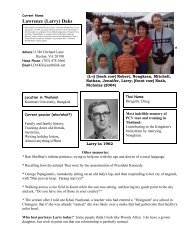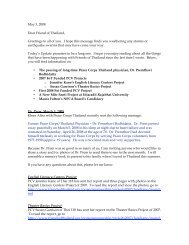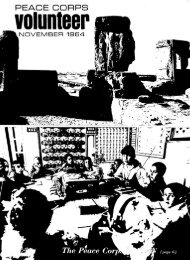TIMES
Peace Corps Times - March/April 1985 - Peace Corps Online
Peace Corps Times - March/April 1985 - Peace Corps Online
- No tags were found...
You also want an ePaper? Increase the reach of your titles
YUMPU automatically turns print PDFs into web optimized ePapers that Google loves.
ICE ALMANAC March/April 1985<br />
From The Field<br />
Coo kstoves/Mali<br />
PCV Ruth Urban has been assisting in<br />
the dissemination of simple woodconserving<br />
cookstoves in Segou, Mali in<br />
association with the women of the Segou<br />
chapter of "L'Union Locale des Femmes<br />
du Mali" (U.L.F.M.) Her account of the<br />
project first appeared in Approvecho Institute?<br />
Cookstove News in October 1984.<br />
It is reprinted here by permission.<br />
Illustrations and building instructions<br />
are taken from a draft booklet on Mali<br />
woodstoves produced by PCVs working in<br />
the dissemination program. Drawings are<br />
by PCV Deborah Hollis.<br />
Women Building Stoves<br />
for Women<br />
From the beginning, the women of<br />
the U.L.F.M. of Segou expressed the<br />
desire to have women build their own<br />
stoves. They also felt very strongly<br />
that people should not be trained to<br />
build stoves professionally. That approach<br />
had been tried in Segou; the<br />
women felt that the prices charged<br />
were too high and that there was a<br />
lack of followup.<br />
Initially, I found considerable resistance<br />
among women to working<br />
with the mud and sand mixture often<br />
used to build simple stoves. Working<br />
with mud is traditionally men's work<br />
in this culture. I also found women's<br />
daily schedules to be quite full. Many<br />
women were unwilling or unable to<br />
spend a lot of time learning to build<br />
stoves. Because of these problems, I<br />
began to work with unemployed or<br />
semi-employed young men. The men<br />
had plenty of free time, and were often<br />
accustomed to doing mud construction<br />
work. I discovered, however,<br />
that their motivation to repair<br />
the stoves once built, and to build new<br />
stoves was generally very low. Often,<br />
too, they were unable to do further<br />
work because of other commitments<br />
or because they had left the household.<br />
For these reasons, I now insist that<br />
the majority of any training group be<br />
women. A few very enthusiastic<br />
women have shown other women that<br />
they can, indeed, work with mud, and<br />
the choice of a very simple stove<br />
model has shortened the training sessions,<br />
allowing many women to 'arrange<br />
their household tasks in order<br />
to attend. Finally, I have been able to<br />
rely very heavily on the neighborhood<br />
U.L.F.M. groups to organize<br />
women for training sessions. 1 am<br />
preparing these structures to take<br />
over my work when I leave.<br />
A Simple Model<br />
I feel that a very crucial element of<br />
the success I am beginning to find in<br />
teaching women to build their own<br />
stoves was the choice of a very simple<br />
stove model. I am teaching people to<br />
build one-pot stoves from a sand and<br />
mud mixture. Because the preparation<br />
of some local dishes requires that<br />
cooking pots be very securely supported,<br />
the traditional three potsupporting<br />
rocks are left in place and<br />
the circular walls of the improved<br />
stove are built around and on top of<br />
them. A 1 cm gap is carved between<br />
the widest part of the pot and the<br />
stove walls, which extend almost to<br />
the pot lip. The smoke leaves through<br />
this gap. An arch-shaped door is<br />
carved between two of the rocks to<br />
allow wood to be added. We try to<br />
build, in each household, at least one<br />
stove for each regularly used pot, as<br />
these stoves should only be used with<br />
the pots for which they were designed.<br />
I have found this stove to have<br />
several advantages over more complicated<br />
stoves with chimneys, often designed<br />
to be used with several cooking<br />
pots at a time. One-pot stoves are very<br />
easv and fast to build. Given four to<br />
six trainees, we have found we can<br />
build up to five stoves in a morning.<br />
Some of the trainees are able to immediately<br />
build their own stoves. The<br />
stoves are inexpensive as no cement<br />
or metal is used.<br />
The women tell me thev like the<br />
stove because it saves wood, reduces<br />
the amount of heat and smoke they<br />
are exposed to, holds the pots very<br />
firmly, and reduces cooking time considerably.<br />
The stove requires very little<br />
adaptation by the women as the<br />
cooking techniques for the stove and<br />
for the traditional three-rock fire are<br />
almost identical. I have not been able<br />
to do auantitative tests; but the savings<br />
in wood is noticed and often remarked<br />
upon by the women who use<br />
the stoves and bv the men who buv<br />
the wood. ~inalli, none of the somk<br />
25 families for which we have built<br />
stoves have abandoned them.<br />
A Few Problems<br />
While I am pleased to have facilitated<br />
the dissemination of woodstoves<br />
in Segou, I do see a few problems. As<br />
smoke is not completely evacuated<br />
from the kitchen, its health hazards<br />
are not eliminated. The mud and<br />
sand stove needs constant upkeep, as<br />
does any mud structure. Finally, the<br />
stove is not portable, making it unsuitable<br />
for families who rent housing.<br />
The introduction of lightweight,<br />
portable stoves in addition to mud<br />
and sand stoves seems desirable.<br />
Training Tips<br />
When I supervise a training session<br />
now, I try to invite one or more people<br />
who have participated in previous<br />
training sessions. I ask these people to<br />
explain and demonstrate construction<br />
techniques tu thc trainees. I have<br />
(cotzfltr ~ted otl pige 14)<br />
Peace Corps 'l-inlr.\/lC:l:. Almanac 13<br />
\













